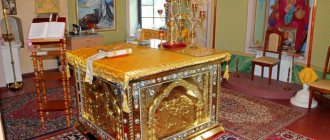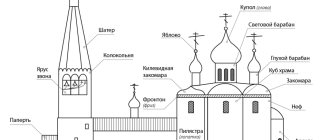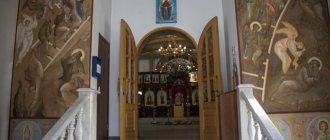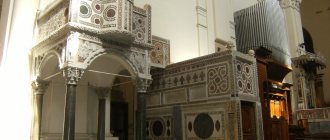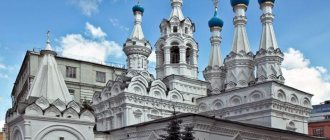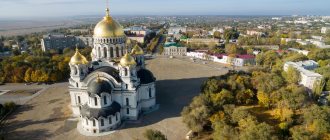Varieties of aisles
In terms of layout, chapels can also differ significantly from each other. These can be naves parallel to each other, separated from each other by only a few columns in a basilica church, or they can be bizarrely located rooms isolated from each other, as in the already mentioned St. Basil's Cathedral. Chapels can also be located in the choir of the temple or, for example, in an underground room. Finally, church buildings with chapels located in extensions to the main building are common.
Features of use
The construction of multi-altar churches or the addition of new aisles to an existing church building has four main goals:
1. Aesthetic-architectural
, associated with the style of the building and the creative self-expression of its author.
2. Utilitarian-practical
– when dividing the temple into winter and summer parts, see above.
3. Spiritual-practical
. The fact is that in the Orthodox Church there is a rule according to which the Liturgy can be celebrated on one altar only once a day. The presence of several chapels in the temple makes it possible to perform two or more Liturgies, which is especially important if the temple has many parishioners.
4. Spiritual
. Each chapel of the temple has its own dedication: to the Lord (in honor of some of the events of Sacred history), to the Most Holy Theotokos (in honor of the Mother of God feast or icon), a saint or an angel. Mystically, the chapel is a small temple. History knows many cases when chapels were added to existing churches in order to honor one of the saints - with a prayer for help or in gratitude for a heard request.
Side chapel
The southern aisle of St. Savva of the Storozhevsky Cathedral of the Nativity of the Virgin Mary of the Savvino-Storozhevsky Monastery The aisle is either a specially designated part of the main building of the temple, or an extension (usually on the south or north side) to accommodate an additional altar with a throne for worship.
These additional compartments can take different forms and be distributed differently in the space of the temple, complicating its structure and sometimes turning it into a whole complex.
Side chapels or pareclesias or chapels are arranged, in particular, to install an additional altar(s) in the church, so that more than one liturgy can be celebrated in one church on one day, since in the Orthodox Church it is customary to perform no more than one liturgy on one day in one throne.
A piece of relics is placed at the base of the throne
A very interesting point is that a piece of the relics of a martyr is necessarily placed at the base of the throne.
This continuity already comes from antiquity: for the first three centuries after the Nativity of the Savior, while under persecution, Christians performed their most important sacred rite - the Divine Liturgy - somewhere in the catacombs or underground burials.
The Tabernacle of Meeting is the Jewish camp temple.
And they certainly did this over the tombs of those who, with their lives, even to death, testified to the incarnate Savior that He conquered death. After all, this is exactly how a martyr is initially translated from ancient Greek as a witness.
The consecration of the temple and its dedication to God is an ancient and everlasting custom of the Church of God. Moses, at the command of God, consecrated the tabernacle and its accessories (Gen. 40:9).
This is exactly how the Jewish prophet and founder of Judaism Moses was portrayed in the Bible. It was he who, at the command of God, consecrated the tabernacle and all its accessories
Solomon consecrated the temple he had newly created and celebrated the consecration for seven days (2 Chron. 7, 8-9).
After the captivity of Babylon, the Jews under Ezra renovated the second temple (1 Ezra 6:16), and after the cleansing of the temple from the persecution of Antiochus, they established the annual seven-day festival of Renewal.
The tabernacle and temple were consecrated by bringing in the ark of the covenant, singing a sacred song, sacrifice, pouring out sacrificial blood on the altar, anointing with oil, prayer and a national holiday (Ex. 40; 1 Kings 8 ch.).
Holy Fathers about the lighting of the temple
In the writings of the Holy Fathers of the Church, close attention is not paid to the issues of lighting the temple space , however, individual comments are found in the Church. Cyprian of Carthage, St. Simeon the New Theologian, St. Gregory Palamas and St. Simeon of Thessalonica. Some reflections on this topic are also contained in the works of more modern theologians and scientists: St. right John of Kronstadt, Fr. Pavel Florensky, Fr. Lev Lebedev, professors V.N. Lossky and N.D. Uspensky.
The main ideas contained in these works are the famous Russian church architect M.Yu. Kesler summarized as follows: “The light in the temple is, first of all, an image of a special, immaterial, uncreated, Divine light, essentially different from the external, natural, material. External light is allowed inside the temple only as an image of this immaterial light..., since light in the proper sense for the church consciousness is only Divine light, the light of Christ, the light of future life in the Kingdom of God, which is symbolically reflected by the architecture of the Orthodox church."
M.Yu. Kesler
The chapel is primarily an altar where services are performed.
Let's take a closer look at what a chapel is and what it contains. First of all, this is the altar - the main place of the entire Orthodox church. It is in the altar that the main divine service of the entire Christian church is performed.
The word altar comes from the Latin words “alta” and “ara”: an elevated altar or an altar placed on a raised platform.
Only men are allowed to enter the altar; women are not allowed to enter there, because the altar is considered a holy place
It really was always located on a hill compared to the rest of the temple area. Why is that? The altar is a symbol of the Throne of the Lord.
The altar consists of the following important parts:
Altar - a table that is located in the central part of the altar. It is here that the Sacrament of the Eucharist is celebrated, and only priests can touch this table. For laymen this is prohibited.
The lower cover of the Throne is called catasarca, the upper one is called indium, which translated from Greek means “I dress.”
The covering that is used to cover the altar with all the sacred objects on it at the end of the service is called the veil.
In the diagram you can see what is in the altar. The Throne, where the Antimins, the Cross, the Gospel and the Tabernacle are located
The altar is a quadrangular table located in the northeastern part of the altar (to the left of the throne). It got its name from the fact that during proskomedia, bread in the form of prosphora and wine are prepared in a special way for the Sacrament of the Eucharist.
Sacred vessels are stored on the altar until used in the liturgy; it is a sacred place that only clergy are allowed to touch;
Sacristies are a special place located to the right of the throne, where clergy dress in special clothes.
This sacristy stores all the liturgical clothes of priests, deacons and subdeacons, which are necessary for the celebration of the liturgy.
There are also all the liturgical books needed during the Divine Liturgy.
But in Bulgarian churches, especially in ancient churches, the sacristy most often becomes the most ordinary wardrobe or even a simple table.
The high place is a part of the Orthodox church, which is located at the central part of the eastern wall of the altar directly opposite the throne. The mountainous place has ancient origins. In the catacomb crypts and chapels, a cathedra (seat) for the bishop was built on this site.
Number 1 depicts the high seat on which the bishop sits during the Divine Liturgy; number 2 shows the throne.
It is impossible not to notice the altar in the temple, because the prototype of the Throne should be the most beautiful. They always try to decorate and highlight it.
During the Divine Liturgy, the priest either leaves the altar or re-enters it. This happens throughout the liturgy.
Only a few can enter the altar. But it is there that preparation for the Sacrament of the Eucharist takes place. And yet, every baptized man has been to the altar at least once, even if he doesn’t remember it at all.
Values
The word “limit” (correctly written with the prefix “pre-“) is used in the following meanings:
- A certain line, a boundary line, clearly indicated or not: “beyond the Motherland”; "travelling distance limit". Synonym for "border". Partial synonyms “edge”, “edging” (for areas not equipped with man-made structures – “hilly limits of the valley”, “limit of advancement along the slope”, etc.), “border” (mainly for specially equipped areas – “limits the pastures are visible along the fence").
- The extreme degree, the final stage of the process, the last in a series of events: “the limit of dreams,” “the limit of design improvement”; “Will there be a limit to your antics?!” Synonym for "top"; partial “edge”, “edge”, “maximum”, “frontier”.
- The numerical value to which a number sequence, series, function tends: “The number π is obtained as the general limit of sequences to which the sums of the lengths of the sides of regular polygons inscribed in a circle and circumscribed around it tend, with an unlimited increase in their number.” Synonyms “limit”, lim (in specialized literature). Do not confuse the limit of a function with its asymptote and extrema (maxima, minima)!
- Small homeland, native land, home in the sense of a home, a somehow delimited area of space (usually used in the plural): “Having returned to my native borders, I was amazed at the changes that had taken place in them.” Partial synonyms “region”, “country”.
- Established (stable) state (also mainly in the plural): “The birth of a child at first unsettled us, but over time our life entered new, familiar limits.” Partial synonyms “rut”, “channel” (allegorical).
What does “altar” mean?
A chapel of a temple is an extension to it, serving for religious purposes when holding services in the main temple building is undesirable for some reason. The word “chapel” must be written with the prefix “pri-“. The chapels of Christian churches are generally of the following types:
- The so-called summer churches, built at parish churches (on the left in the figure). They serve in the summer chapel not only in the cold season to save on heating costs, but also every day when there is a small influx of parishioners, but holiday services are invariably held in the main church. A Christian summer chapel is built, as a rule, on the southern or northern side of the main church, so that the altar can be placed at the eastern side and the worshipers stand facing there, as it should be. Partial synonyms of “dungeons” (if the chapel has a common wall with the main church), “chapel” (dungeon in a Catholic church), “nave” (for Catholics - a chapel separated from the main religious space not by a blank wall, but by an arch and/or columns ).
- An independent religious building as part of a temple complex, (usually dedicated to one saint or sacred event), services in which can be held in parallel (along with) those in the main temple. On the right in Fig. The chapels of St. Basil's complex are indicated. Partial synonym for "church".
- An extension to the cathedral church, open to the inside, used for performing individual religious actions (confession, baptism, communion, or storing religious paraphernalia). Partial synonyms according to the purpose: “confession room”, “baptistery” (“baptistery” for Catholics), “sacristy”, etc.
Note: do not confuse the chapel of the temple with the porch to it, which is essentially the entrance hall to the temple.
Grammar
The word “limit” is an inanimate masculine noun of the 2nd declension in the school tradition (I academic). Consists of the prefix “pre-” and the root “-del”. A number of modern linguists recognize it as consisting of only one root, but the “altar” is a clear contradiction to this. Separation by hyphenation of pre-deeds. Case forms:
- Nominative: limit (singular); limits (plural).
- Genitive: limit (singular); limits (plural).
- Dative: limit (singular); limits (plural).
- Accusative limit (units); limits (plural).
- Instrumental: limit (singular); within limits (plural).
- Prepositional: <about, about, in, on, at> limit (singular); <about, about, in, on, at> limits (plural).
The noun “altar” differs only by another prefix – “at-“; tends similarly.
***
Church of John the Baptist in Tolchkovo. Yaroslavl
A chapel is a room in a church consisting of an altar and a naos (a space intended for the laity) - that is, a place where church services can be held. What we call the main volume of the temple is the central or main chapel. If other rooms with a separate altar and altar are attached to the temple, they are called side chapels. Or simply chapels, since the main chapel is the main one, in order to be perceived and called the temple itself.
Savvinsky chapel of the Nativity Cathedral of the Savvino-Storozhevsky Monastery in Zvenigorod. The cathedral was built at the very beginning of the 15th century. The chapel was added later - in the middle of the 15th century
Why are chapels needed?
Why add additional space for church services to an existing church?
Firstly, so that several services can be performed on one day. The fact is that according to the Orthodox canon, liturgy can be performed on one altar only once a day. Side chapels with separate altars and altars made it possible to increase the number of services in the temple during the day.
Secondly, Russian stone churches were important religious centers. Local spiritual life took shape around them, striving to expand the “space of heavenly protection.” This was solved, among other things, by creating chapels - small churches dedicated to Christ, the Blessed Virgin Mary or locally revered saints. Each chapel was not just an extension for worship, but was separately consecrated in honor of the events of sacred history or an individual saint.
And by the way, if the reconsecration of the temple was still a rather rare event, then the chapels were reconsecrated quite often - depending on the current preferences of the abbots or parishioners. Just as often, old, dilapidated chapels were simply rebuilt as new, consecrating them in honor of other saints.
Other names: chapel, dungeon

